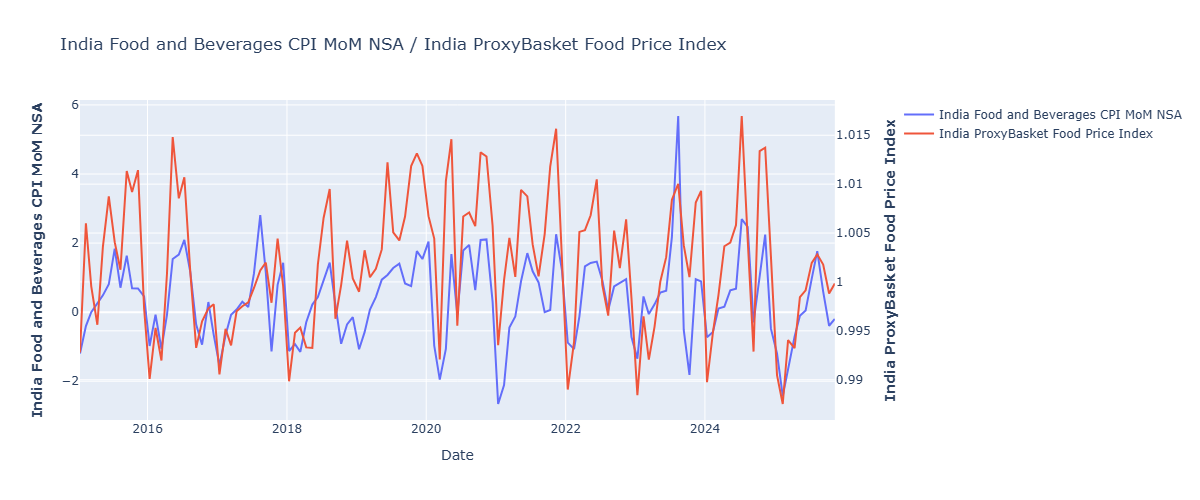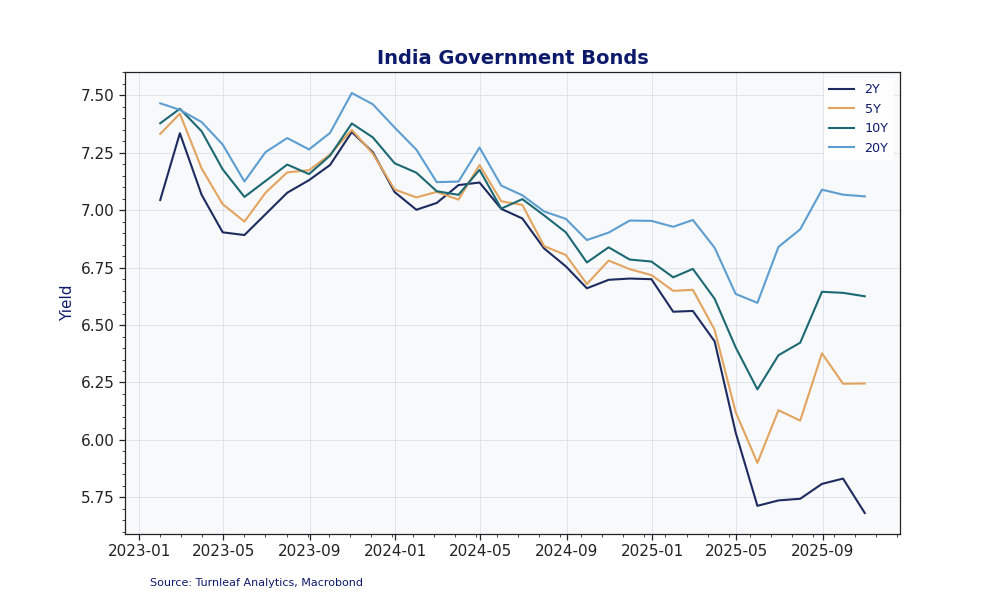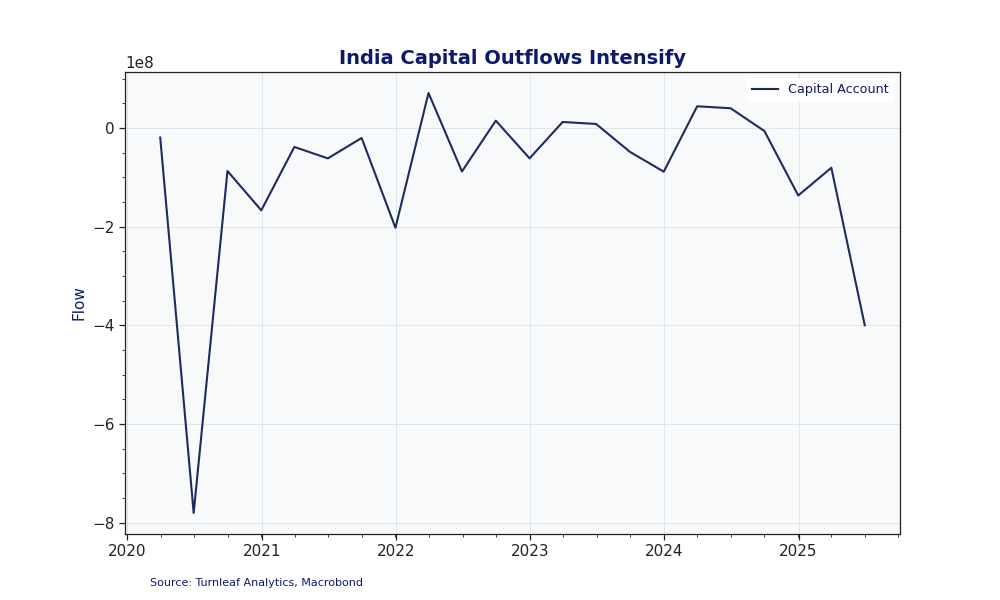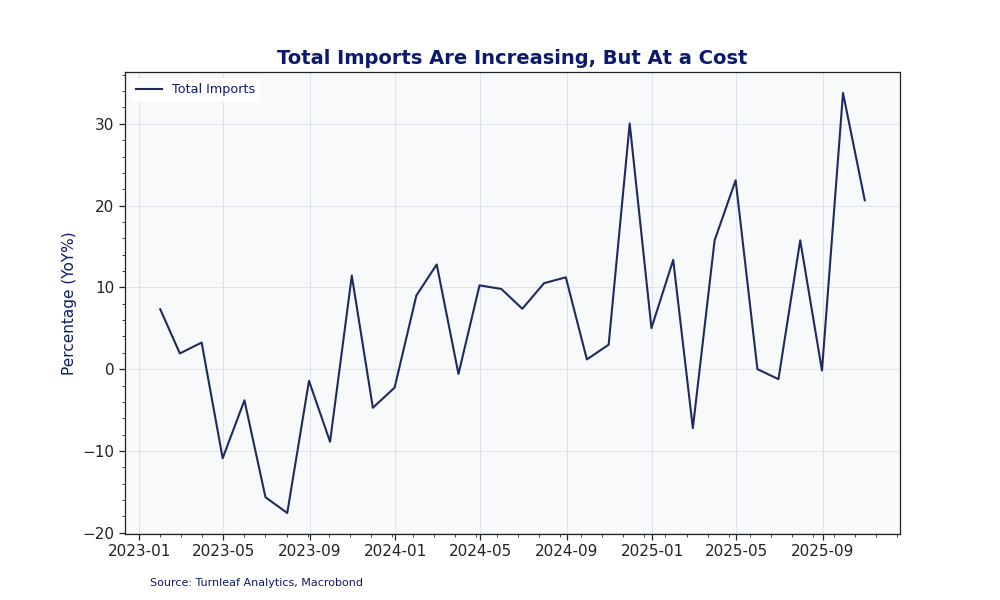Featured Research
Macroeconomic Insights: India CPI – Structural Pressures Emerge
In the past month Turnleaf's 12-month inflation forecast for India has edged lower as the pace of food and energy price increases slowed. This moderation reflects seasonal dynamics and temporary declines in current market prices rather than any meaningful improvement...
Macroeconomic Insights: India CPI – Structural Pressures Emerge
In the past month Turnleaf’s 12-month inflation forecast for India has edged lower as the pace of food and energy price increases slowed. This moderation reflects seasonal dynamics and temporary declines in current market prices rather than any meaningful improvement in the structural forces that keep inflation elevated. Turnleaf’s models show that despite current disinflation, external cost channels including exchange-rate depreciation, tightening freight markets and rising forward energy prices are already rebuilding inflationary pressure beneath the surface. We expect external frictions to continue to push inflation above 3%YoY by the end of 2026 (Figure 1-PAID).
Record Low Food Prices Creates Rebound Risk
India’s headline CPI inflation slowed to 0.25% YoY in October 2025, largely because food inflation fell to -5.02% YoY. The decline was concentrated in vegetables—especially tomatoes, onions and potatoes—as prices normalized after mid-year supply shocks. Turnleaf’s ProxyBasket Food Price Index captured this move by incorporating daily tomato, onion and potato prices, as well as other inputs like India Agricultural Index that help trigger supply interventions and minimum sell prices for farmers (Figure 2).
Figure 2

This unusually low October reading creates a very low base for 2026, so even modest food price increases next year are likely to lift YoY food inflation. Although current data point t higher rainfall and increased sowing in the second half of 2026, any weather-related shock will be amplified by this base effect. Monitoring climate indicators together with Turnleaf’s alternative data like NASA weather metrics and minimum price triggers will be essential to gauge emerging food inflation risks.
Currency Depreciation and External Cost Pressures
The rupee weakened to 89.39 INR/USD as of November 27, 2025, down 5.82% over twelve months and 1.30% in November alone, driven by acute trade frictions with the U.S. and foreign portfolio outflows. Over the past month, 5- and 10-year government bond yields have edged higher while the 2-year remains near cycle lows, indicating that markets are demanding a higher term premium for inflation and fiscal risks even as they continue to price in near-term RBI easing (Figure 3).
Figure 3

Capital flows show about $400 million leaving India in 2025Q2 as global trade volatility weakened appetite for emerging-market risk (Figure 4). For India, this pressure has been amplified by the U.S. decision to impose a 50% tariff in response to India’s deepening energy ties with Russia. Since the start of the war in Ukraine in 2022, Russia’s share of India’s crude imports has jumped from under 1% to nearly 40%, increasing India’s exposure to geopolitical shocks.
Figure 4

Currency depreciation compounds external cost pressures through dollar-denominated freight and commodity prices, effectively hitting India twice. With global shipping costs still slightly above pre-shock norms, imports are more expensive both because of higher USD prices and the weaker rupee. Despite some slowdown after a peak above 30% YoY in September 2025, import volumes—equivalent to 23.5% of GDP in 2024—continue to grow, reinforcing the upside risk to India’s inflation outlook into 2026 (Figure 5).
Figure 5
 To read the rest, visit Turnleaf’s latest Substack post here.
To read the rest, visit Turnleaf’s latest Substack post here.
Research Archive
Macroeconomic Insights: United States CPI – Firms are Still Front-Loading
To date, uncertainty has been the defining feature of the inflation story. Volatile trade policy has deterred many firms from making strategic investments, slowing business...
Macroeconomic Insights: FX, Oil, Copper, and Tariff Risks in Emerging Markets
Across Colombia, Chile, Brazil, and China, inflation dynamics are currently shaped by common external themes: exchange rate movements, global commodity prices—particularly...
Twenty years in financial markets
Time is a curious thing. We say time passes, yet rather than simply pass, time tends to dissolve. Once gone, it dissolves leaving an imprint behind. At times, it's a clear...
Macroeconomic Insights: Czech Republic CPI – House Prices on the Rise
Recently, housing prices in the Czech Republic have increasingly exerted upward pressure on inflation. Our June 2025 Forecast Word Cloud highlights the primary drivers...
Macroeconomic Insights: Malaysia CPI – Electricity Tariff Reform from July 2025
Malaysia has changed its electricity tariff schedule, and allegedly, it should save the average consumer up to 19% on their bills. However, after an announcement in June 2025,...
Macroeconomic Insights: Hungary CPI – Food Prices on the Rise
At the end of May 2025, the Orban government decided to extend the profit margin cap on 30 essential food items through August 2025, in line with previous guidance stating the...
Macroeconomic Insights: Vegetable Prices Push India Inflation Downwards
In 2024, volatile vegetable prices repeatedly triggered in-market releases from India’s Price Stabilisation Fund (PSF). PSF, launched in 2014–15, was designed to curb extreme...
Macroeconomic Insights: Israel CPI – The Cost of War
Over the past 24 hours, Israel’s strike on Iran has markedly increased upside risks to inflation in the country. Just as tariffs introduce additional costs to consumers,...
Macroeconomic Insights: Spain CPI – Is it Time to Buy a House?
Since the start of the year, housing market indicators have increasingly correlated with rising inflation pressures. Interestingly, Spain classifies mortgages as financial...
Macroeconomic Insights: United States – A Bad Economy in a Good Economy
Our United States CPI YoY, NSA model continues to flag two quiet but disinflationary forces: a moderate rise in unemployment and trends in disability-program flows. To qualify...
Neudata New York conference 2025
When you're in New York, there are several things you have to have, a burger (preferably from Minetta Tavern), a cookie (preferably from Levain bakery on the Upper East Side) and...
Macroeconomic Insights: Trump Announces a Trade Deal With China. Will U.S. Inflation Go Down Now?
There’s just something about being in Geneva that makes you want to reduce tariffs on all Chinese goods from 145% to 30%. Recently, the U.S. and China reached an agreement to...
Trip notes from USA
Over the past week and half I’ve been travelling in America, starting with Chicago, then Omaha and finally New York. I’ve met many clients and attended various financial events,...
Macroeconomics Insights: Eurozone Inflation and The Price of Fun
On April 28, 2025, at approximately noon, I couldn’t send a message to a colleague. I thought there must have been a problem with my WIFI, until I realized that none of the...
Macroeconomic Insights: China Inflation & The Uncertainty Pandemic
Based on recent weekly forecasts, Turnleaf is projecting deflation of -0.09%YoY in April 2025 as export growth is expected to contract and China begins to reorganize its economy...